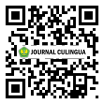LEXICAL CHANGES IN BAHASA MELAYU NUSANTARA AT SYNTACTIC LEVEL: A DIACHRONIC STUDY
DOI:
https://doi.org/10.37301/culingua.v2i2.74Keywords:
semantic change, syntactic change, transitivity, verbs, etymologyAbstract
The study of linguistic changes, including semantic changes and syntactic changes are parts of the etymology study. Any changes experienced by a language can occur due to the influence of external factors such as politics, socials, religions, or cultures; as well as the internal factors. The internal factors in question are changes in one or more linguistic aspect(s) that could affect each other. The morphological changes of a word, for example, can make changes in the semantic or syntactic aspects. This paper aims to find out which linguistic aspects of Malay words, especially verbs, which are still used in the Indonesian language to date that change over time, and to explain how the changes in verb’s meaning affect the transitivity of the verbs. The data of this study are obtained from several Malay and Indonesian corpora. Those corpora are then set diachronically (from the 1300s to the 2000s) to analyze the meaning changes of the verbs. By applying the corpus linguistics approach and the transitivity analysis, this study has produced some patterns of semantic changes at the syntactic level, which can contribute to etymological information of Bahasa Melayu Nusantara vocabulary.
References
Abdullah, I. H. (2000). Pluasan Semantik Kata Sifat Rasa: Manis, Pahit, Masin, dan Tawar. Jurnal Dewan Bahasa, 44(5), 563–572.
Alwi, H., & et.al. (2003). Tata Bahasa Baku Bahasa Indonesia (3rd ed.). Jakarta: Balai Pustaka.
Aritonang, B., & et.al. (2000). Verba dan Pemakaiannya dalam Bahasa Indonesia. Jakarta: Pusat Bahasa.
Durkin, P. (2009). The oxford guide to etymology. New York: Oxford University Press.
Geeraerts, Dirk. (2010). Theories of Lexical Semantics. Oxford: Oxford University Press.
Grzega, J., & Schöner, M. (2007). English and General Historical Lexicology. Katholische Universität Eichstätt-Ingolstadt, 1(July), 1–73. Retrieved from http://www1.ku-eichstaett.de/SLF/EngluVglSW/OnOnMon1.pdf
Hopper, P. J., & Thompson, S. A. (1980). Transitivity in Grammar and Discourse. Language, 56(2), 251. https://doi.org/10.2307/413757
Jalaluddin, N. H., Ahmad, Z., & Saad, N. H. M. (2010). Peluasan makna imbuhan ber-: Analisis semantik kognitif. GEMA Online Journal of Language Studies, 10(1), 103–123.
Keller, R. (2005). On language change: The invisible hand in language. London, England: Taylor and Francis.
Kridalaksana, H. (2005). Kelas Kata dalam Bahasa Indonesia. Jakarta: PT Gramedia Pustaka Utama.
Kroch, A. (2001). Syntactic changes. In Baltin, Mark and Chris Collins. In The Handbook of Contemporary Syntactic Theory. pp. 698-729 Oxford: Blackwell Publishers.
Leipzig Corpora. (n.d.). Retrieved from http://corpora.uni-leipzig.de/en?corpusId=ind_mixed_2013
Pemadam Kebakaran Kabupaten Bogor. (2010). "Asuransi Bagi Sang Penakluk Api". In damkarkabbogor.blogspot.com Retrieved 16th April 2018, from http://damkarkabbogor.
blogspot.com/2010/01/asuransi-bagi-sang-penakluk-api.html.
Proudfoot, I. (2012). Malay concordance project. Retrieved from University, Australian National website: http://mcp.anu.edu.au/Q/info.html
RezaFahmi. (2015). "Potret Kehidupan Malam Pattaya (Walking Street) yang Menggilakan". In jalansepat9.wordpress.com. Retrieved 16th April 2018, from https://jalansepat9.wordpress.
com/2015/01/07/potret-kehidupan-malam-pattaya-walking-street-yang-menggilakan/
Riddell, P. G. (2012). From Kitab Malay to Literary Indonesian: A Case Study in Semantic Change. Studia Islamika, 19(2), 277–312. https://doi.org/10.15408/sdi.v19i2.362
Tim Penyusun. (2016). Kamus Besar Bahasa Indonesia (5th ed.). Jakarta: Badan Pengembangan dan Pembinaan Bahasa.
Tim Penyusun. (2017). Tata Bahasa Baku Bahasa Indonesia (4th ed.). Jakarta: Badan Pengembangan dan Pembinaan Bahasa.
Tsunoda, T. (1999). Transitivity and Intransitivity. Journal of Asian and African Studies, 57(57), 1–9.
tvOneNews. (2017). “Era Baru Amerika”. In tvOneNews Facebook Page. Retrieved 16th April 2018, from https://www.facebook.com/tvOneNews/photos/era-baru-amerika-saksikan-tvone-melaporkan-langsung-dari-amerika-serikat-malam-i/1408393695880176/
Downloads
Published
Issue
Section
License
Copyright (c) 2021 Dewi Puspita, Hermina Sutami

This work is licensed under a Creative Commons Attribution 4.0 International License.









